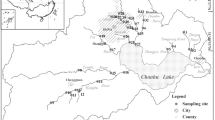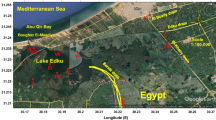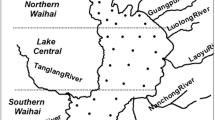Abstract
Phosphorus (P) fractions and their bioavailability in the sediments from the middle and lower reaches of the Yangtze River region were investigated using different chemical extraction methods. The results show that the contents of bioavailable P in the sediments extracted by different extraction procedures varied greatly. But their rank order was similar. Potentially releasable P (PRP) was the largest, followed by algal available P (AAP), NaHCO3 extractable P (Olsen-P), water soluble P (WSP), and readily desorbable P. PRP contributed approximately 60% to total P (TP) in most sediments, AAP 20%, Olsen-P 15%, WSP 2%, and readily desorbable P (RDP) 0.5%. For the heavily polluted sediments, their bioavailable P extracted from TP mainly originated from inorganic P (IP), IP mainly originated from NaOH–P, the bioavailable P concentrations can be evaluated by measuring the concentrations of TP, NaOH–P, and IP. For the slightly polluted sediments, the bioavailable P can only be evaluated by different chemical extractable methods.
Access this article
We’re sorry, something doesn't seem to be working properly.
Please try refreshing the page. If that doesn't work, please contact support so we can address the problem.




Similar content being viewed by others
References
Abrams MM, Jarrell WM (1995) Soil-phosphorus as a potential non-point source for elevated stream phosphorus levels. J Environ Qual 24:132–138
Andrieux F, Aminot A (1997) A two-year survey of phosphorus speciation in sediments of the Bay of Seine (France). Cont Shelf Res 17:1229–1245
AWWA, APHA, WPCE (1998) Standard methods for the examination of water and wastewater (18Ed.). American Public Health Association Press, Washington, DC
Axt JR, Walbridge MR (1999) Phosphate removal capacity of palustrine forested wetlands and adjacent uplands in Virginia. Soil Sci Soc Am J 63:1019–1031
Bostrom B (1988) Relations between chemistry, microbial biomass and activity in sediments of a polluted vs. a nonpolluted eutrophic lake. Verh Int Ver Limnol 23:451–459
Cai QM, Gao XY, Chen YW, Ma SW (1995) Dynamic variations of water quality in Taihu Lake and multivariate analysis of its influential factors. J Lake Sci 7(2):97–106
Cai QM, Gao XY, Chen YW, Ma SW, Dokulil M (1997) Dynamic variations of water quality in Taihu Lake and multivariate analysis of its influential factors. J Chinese Geogr 7:72–82
Chang SC, Jackson ML (1957) Fractionation of soil phosphorus. Soil Sci 84:133–144
Das BM (1990) Principles of geotechnical engineering, 2nd edn. PWS-KENT, Boston, MA
Dorich RA, Nelson DW, Sommers LE (1984) Availability of phosphorus to algae from eroded soil fractions. Agric Ecosyst Environ 11:253–264
Dorich RA, Nelson DW, Sommers LE (1985) Estimating phosphorus in suspended sediments by chemical extraction. J Environ Qual 14:400–405
Elizabeth PK, Janet SH, Aaron LM, George MH (2002) Changes in the sorption capacity of Coastal Plain sediments due to redox alteration of mineral surfaces. Appl Geochem 17:387–398
Fan CX, Ji J, Wu WH, Qing BQ, Chen KN, Chen YW (1997) Comprehensive evaluation and preliminary prediction for water quality and eutrophication of Gonghu Bay. Trans Limnol Oceanogr 3:18–24
Friend MT, Birch HF (1960) Phosphate responses in relation to soil tests and organic phosphorus. J Agric Sci 54:341–346
Gibson CE (1997) The dynamics of phosphorus in freshwater and marine environments. In: Tunney H (ed) Phosphorus loss from soil to water. CAB International Press, Oxon, pp 121–144
Gonsiorczyk T, Casper P, Koschel R (1998) Phosphorus binding forms in the sediment of an oligotrophic and an eutrophic hardwater lake of the Baltic district (Germany). Water Sci Technol 37: 51–58
Institute of soil science, Chinese Academy of Sciences (1978) Physico-chemistry analyze of Soil. Shanghai science and technology publishing company, Shanghai, pp 35–45
Jin XC, Liu HL, Tu QY (1990) Eutrophication of lakes in China. Chinese Environmental Science Press, Beijing
Jin XC, Liu SK, Zhang ZS (1995) Lakes in China research of their environment (volume two). China Ocean Press, Beijing
Jin XC, Wang SR, Pang Y, Wu FC (2006) Phosphorus fractions and the effect of pH on the phosphorus release of the sediments from different trophic areas in the Taihu Lake, China. Environ Pollut 139:288–295
Li WC (1996) Biological and environmental succession in Wuli bay of Taihu Lake along with the eutrophication processes. J Lake Sci 8(Suppl):37–45
Liu TJ, Chen MQ (2001) Wetland ecological function deterioration in Poyang Lake and counter measures. Chinese J Ecol 20(3):74–77
Liu HH, Jin XC, Jing YF (1999) Environmental dredging technology of lake sediment. Chinese Eng Sci 1:81–84
Long N, James S (2002) Phosphorus fractions and retention in drainage ditch sediments receiving surface runoff and subsurface drainage from agricultural catchments in the North Island, New Zealand. Agric Ecosyst Environ 92:49–69
Ma B, Zhou ZY, Zhang CP, Zhang G, Hu YJ (2009) Inorganic phosphorus fractions in the rhizosphere of xerophytic shrubs in the Alxa Desert. J Arid Environ 73:55–61
Moriarty C (1998) Studies of Irish lakes and rivers. Marine Institute Press, Dublin
Olsen SR, Cole CV, Watanabe FS (1954) Estimation of available phosphorus in soils by extraction with sodium bicarbonate. USDA, Washington, DC
Paludan C, Jensen HS (1995) Sequential extraction of phosphorus in freshwater wetland and lake sediment: significance of humic acids. Wetlands 15:365–373
Penn MR, Auer MT, Van Orman EL, Korienek JJ (1995) Phosphorus diagenesis in lake sediments: investigation using fractionation techniques. Mar Freshwater Res 46:89–99
Psenner R (1988) Fractionation of phosphorus in suspended matter and sediment. Ergebnisse der Limnologie 30:98–113
Psenner R, Pucsko R, Sager M (1985) Fraktionierung organischer und anorganischer Phosphorverbindungen von Sedimenten. Versuch einer Definition ökologisch wichtiger Fraktionen. Archiv für Hydrobiologie Supplement 70:111–115
Qin BQ (2002) Approaches to mechanisms and control of eutrophication of shallow lakes in the middle and lower reaches of the Yangtze River. J Lake Sci 14:193–202
Reddy KR, Overcash MR, Khaled R (1980) Phosphorus adsorption–desorption characteristics of two soils utilized for disposal of animal wastes. J Environ Qual 9:86–92
Ribeiro DC, Martins G, Nogueira R, Cruz JV, Brito AG (2008) Phosphorus fractionation in volcanic lake sediments (Azores–Portugal). Chemosphere 70:1256–1263
Ruban V, Brigault S, Demare D (1999) An investigation of the origin and mobility of phosphorus in freshwater sediments from Bort-Les-Orgues Reservoir, France. Environ Monit Assess 1(4):403–407
Ruban VJF, López SP, Pardo G, Rauret H, Muntau PQ (2001) Harmonized protocol and certified reference material for the determination of extractable contents of phosphorus in freshwater sediments: a synthesis of recent works. Fresenius J Anal Chem 370:224–228
Shen L, Lin GF, Tan JW, Shen JH (2001) Genotoxicity of surface water samples from Meiliang Bay, Taihu Lake, and Eastern China. Chemosphere 41:129–132
Wang SR, Jin XC, Pang Y, Zhao HC, Zhou XN, Wu FC (2005) Phosphorus fractions and phosphate sorption characteristics in relation to the sediment compositions of the shallow lakes in the middle and lower reaches of Yangtze River. J Colloid Interface Sci 289:339–346
Wang SR, Jin XC, Zhao HC, Wu FC (2006) Phosphorus fractions and its release in the sediments from the shallow lakes in the middle and lower reaches of Yangtze River area in China. Colloid Surf A 273:109–116
Williams JDH, Jaquet JM, Thomas RL (1976) Forms of phosphorus in surficial sediments of Lake Erie. Fish Res 33:413–429
Wu FC, Qing H, Wan GJ (2001) Regeneration of N, P and Si near the sediment/water interface of lakes from Southwestern China Plateau. Water Res 35:1334–1337
Xie LQ, Xie P, Tang HJ (2003) Enhancement of dissolved phosphorus release from sediment to lake water by Microcystis blooms: an enclosure experiment in a hyper-eutrophic, subtropical Chinese lake. Environ Pollut 122:391–399
Yan WJ, Zhang JC, Ji M (1999) Characteristics of N, P formation in main rivers of Chao Lake Valley. J Soil Erosion Water Conserv 5(2):35–38
Yang L, Sun J (2001) Phosphorus pollution investigation of Wuli Lake and Meiliang Lake. Environ Monit Manag Technol 13(6):18–20
Yang ZF, Shi WG, Chen LQ, Chen Y, Zhou ZL (2003) Ecological environment succession and countermeasure of East Taihu Lake. Chinese Environ Sci 23(1):64–68
Yuan HQ, Pin XH, Yao XM (2000) Management of water environment of Hongze Lake. Environ Monit Manag Technol 12(1):26–27
Zanini L, Robertson WD, Ptacek CJ, Schiff SL, Mayer T (1998) Phosphorus characterization in sediments impacted by septic effluent at four sites in central Canada. J Contam Hydrol 33:405–429
Zhang YL, Qin BQ (2001) Study prospect and evolution of eutrophication in Lake Taihu. Shanghai Environ Sci 20(6):263–265
Zhou HX, Sheng GY, Sun C, Xu OY (1996) Distribution of organic contaminants Lake Taihu. Water Resour 30(9):2003–2008
Zhou QX, Christopher EG, Zhu YM (2001) Evaluation of phosphorus bioavailability in sediments of three contrasting lakes in China and the UK. Chemosphere 42:221–225
Zhou AM, Tang HX, Wang DS (2005) Phosphorus adsorption on natural sediments: Modeling and effects of pH and sediment composition. Water Res 39:1245–1254
Zhu M, Wang GX, Wang J (2004) Comparative analysis of changes of pollutants in sediment in Nanjing Xuanwu Lake before and after sediment dredging. J Nanjing Normal Univ (Eng Technol) 4(2):66–69
Acknowledgments
Authors wish to thank for the financial support from National Basic Research Program of China (2008CB418200), the National natural science foundation of China (No. 40703017, U0833603), and Chinese Research Academy of Environment Sciences (No. 2007KYYW27).
Author information
Authors and Affiliations
Corresponding author
Rights and permissions
About this article
Cite this article
Wang, S., Jin, X., Bu, Q. et al. Evaluation of phosphorus bioavailability in sediments of the shallow lakes in the middle and lower reaches of the Yangtze River region, China. Environ Earth Sci 60, 1491–1498 (2010). https://doi.org/10.1007/s12665-009-0284-1
Received:
Accepted:
Published:
Issue Date:
DOI: https://doi.org/10.1007/s12665-009-0284-1




